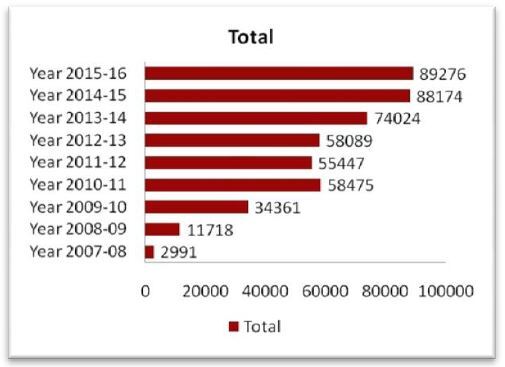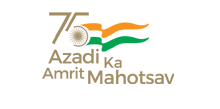Tripura Vision Centre (Tele-ophthalmology) Project
Eye Care Challenge in India
Aim at offering Primary and Preventive Eye Care Services to rural citizens of the country by adopting advances in medical sciences, bio-medical engineering and its convergence with Information and Communication Technology
As per the available statistics, India faces a dismal ratio of ophthalmologist to patient, which is 1:100000. The downside of the entire situation is that 70% of the available doctors practice in the urban areas and 70% population of India resides in rural areas. This leads to a very precarious situation of lack of access of eye care services to the vast majority of the population. Also those who access the services (concentrated in the urban pockets) by travelling to urban areas, incur huge travelling and allied costs and loss of wages. The state of Tripura has area of 10,491 sq. km and a population of 36,71,032, 74% are living in the rural areas. Most of these people are deprived of the primary as well as the preventive eye care service there by creating big difference between the service available in the urban & rural area.
Problem Statement of Tripura
Tripura has been facing acute shortage of Ophthalmologists. There is only one public sector civil hospital, 2nos of Medical College and 3nos Primary Eye Care Centre in the state that serves the need for all the primary & secondary eye care services. Seventy-four percent of the population that resides in the rural areas has to spend considerably on transportation & accommodation to avail the service. At present, a total of 22 Ophthalmologists & 52 Ophthalmic Assistants/Optometrists in public sector are catering the needs of 36lakhs residents. By 2017-18, the numbers of ophthalmologists are estimated to reduce further as out of the 22 Ophthalmologists, 10 will retire from the service & there are only 3 ophthalmologists in the pipeline, implying that only 15 or 18 Ophthalmologists will be available to provide eye care to a projected population of 40lakhs.
Tripura Vision Centre Project

In year 2007, the state of Tripura embarked upon a maiden journey to test the feasibility of using ICT as an enabler and delivery mechanism of eye care services. The proactive approach of Department of Health and Family Welfare, Government of Tripura led to a remarkable success and development of pioneering model of Tele-ophthalmology Project which not only got replicated across the state in next three years but also became immensely celebrated model of Tele-medicine in India.
Tripura Vision Centre Project is a pioneering initiative in delivering eye care services to the previously un-reached rural citizens in the state. The project is conceived and designed by the collaborative effort of the Ophthalmology Department at Indira Gandhi Memorial
(IGM) Hospital under the Department of Health, Government of Tripura, IL&FS ETS and Aravind
Eye Care System. The project aims at offering Primary and Preventive eye care services to rural citizens of Tripura adopting advances in medical sciences, bio-medical engineering and its convergence with Information and Communication Technology. Poised with the challenges of inadequate ophthalmic facilities and limited eye care specialists in the rural areas, this initiative has overcome all geographical, economic, social barriers earlier faced by the rural citizens and helped them in obtaining quality eye care services from Vision Centres located at their doorsteps.
The project currently serves a rural population size of 27.18 lakhs people in remote areas covering 44 blocks of 8 districts in the state of Tripura. The Tripura Vision Centre is a comprehensive model for providing primary and preventive eye care in a decentralized manner using the benefits of Information and communication technologies (ICT) integrated with the medical eye care solutions. The model empowered trained Ophthalmic Assistants/Optometrists to provide eye care services at the grass root level. A total of 44 Vision Centres have been deployed in three phases to render Tele-ophthalmology service across the State of Tripura.
The project was initiated on a public private partnership-PPP format where, The Department of Health and Family Welfare, Government of Tripura was the apex agency through central and state funding. The project was implemented on a phased manner as Phase I, II, III & IV.
In Phase-I, the first pilot Vision Centre was set up in Melaghar block on April '07 and is operational till date. Based on the progress made in Melaghar and significant insight learnt on the local demographics, the project was scaled in phase-II in the West district.
The Phase II comprised of scaling the vision centre network to 10 blocks in West Tripura district covering a population of approximately 15,32,982. The second phase also comprised of the enablement of digital patient medical records in the Vision Centres using database management solution, the “Vision Centre Management System (VCMS)”. It also included setting up of private wireless network with bandwidth of 384 Kbps expandable up to 2Mbps.
In phase III, 29 Blocks of the State were covered to bring a state wide network of Tele ophthalmology services. Apart from setting up Vision Centre infrastructure at 40 + 2 locations, IL&FS also set up a core mini data centre for maintaining electronic medical records and connectivity network operations centre (NOC) at IGM with an ICT enabled real time doctor consultation facility at the Ophthalmology OPD counter at IGM hospital.
Since the year 2010 the Tripura Vision centre project has been managed as an eye care service delivery program comprising of operations and management of 40+2 with a focus on project performance and service delivery
Phase-IV: The Fourth Phase or the present phase was commissioned in the year 2014 with the introduction of four new Vision centres.
So, at present there is 44 Vision Centres are functioning.
The basic aim is to meet the gap between the rural and urban areas with a huge consideration towards reducing the logistics cost. The program has led to:
- This initiative has overcome all geographical, economic, social barriers earlier faced by rural citizens
- The project serves a rural population size of approx 27.18Lakhs rural citizens in the remote areas
- Introduction of information & communication technology to extend the benefits
- Accountability for every single patient
- Cost effective & efficient way of delivering Eye care & Pro-Citizen with vibrant approach.
Performance Analysis
The Tripura Vision Centre Project is a pioneering initiative in delivering Primary & Preventive Eye Care services to the previously un-reached rural citizens of the State. This initiative has overcome geographical, economic, social barriers earlier faced by the rural citizens and helped them in obtaining quality eye care services from Vision Centres located almost at their doorsteps.

Till March 2016, the project has screened 4.72 lakh patients across all the 44 Vision Centres of this 55% were males and rest 45% were females. The number of women screened in the Vision Centres is more than 40%. The trend shows that higher number of women are accessing the services of the VCs as compared to earlier trends, as they are have access the services closer to their homes and does not involve long distance travelling. The daily routine and the earnings of the people are not affected much due to the proximity of these centres.

Only 5.84% of the total patients screened were referred to the IGM Hospital, Agartala. Majority of the eye problems are diagnosed and treated at the Vision Centres after tele-consultation and only a small number of patients are referred for further treatment. Had these vision centres not been established, much of these patients would have travelled to IGM Agartala or would have continued to stay with their eye problems leading to the needless Blindness at certain stage.
Spectacles have been prescribed for about 1, 28, 815 patients till date. Thus the presence of vision centres has played a major role in reducing the needless blindness due to refractive error in the State and in turn has contributed to the productive Human Capital of the State.
The inherent benefits of setting up the ICT enabled vision centres are:
- Affordable eye care option
- Early Diagnosis of eye ailment without having to visit the hospital
- Timely Management of the Ailments
- Health Education/Awareness creation at the village level
- Accountability and Maintenance of Eye Health Profile of the village.
- Escalation of secondary and tertiary care patients to the correct health care service providers enabling patients to take informed decisions based on their assessed eye ailments or requirements.
- Avoiding mislead decisions, loss of limited financial resources on wrong treatments and exploitation of commercially driven private medical facilities.
- These centres are boon to the people of Tripura as they have reduced their travel time and also the other associated costs; thus increasing the productivity and effectively contributing to the overall welfare of the State.
These centres over the years now have been able to screen significant proportion of eye conditions such as Refractive Error, Cataract, Glaucoma, Keratitis, Diabetic Retinopathy, Infections, fundus examination and some low vision care. The objective with which these centres were established has been achieved and in fact they have slowly adding value is secondary screenings and cross referrals.
Add On Services
Diabetes Check-up: The lifestyle diseases in India are on the rise and diabetes leads to diabetic retinopathy if the same is not diagnosed on time and necessary preventive care is not designed. DR is also coming up as a significant contributor to the preventable blindness with the increased focus of NPCB on early identification and treatment of DR. As a pilot initiative it has been proposed to undertake Glucose check of all patients who are more than 40 years of age. Those who will be identified with Diabetes will be asked to undergo DR test at Vision Centers where Fundus cameras are being installed.
Installation of Fundus cameras: Two Vision Centres are going to equipped with non-mydriatic fundus cameras so that these two locations could be developed as focal screening centers for diabetic retinopathy. Diabetes screening of all patients above 40 years and all patients who will be identified with Diabetes will be asked to undergo DR screening as well. This will help in bundling comprehensive services under the project.
Awards and accolades
The Project has been awarded with different awards as follows :
The Tripura Vision Centre Project has awarded
- National e-Governance “Gold” Award in 2008-09.
- “e-INDIA Award” in 2009-10.
- “Manthan Award South Asia 2010” in 2010-11
- “e-North East Award” in 2011-12
- “e-INDIA Award” in 2011-12
- “Web Ratna Award” in 2012-13
From the above awards it means that the Project establish its national & international character to serve the rural people of the state. This is one of the flagship projects benefitting the rural people of the State and is functioning very well. We need to support this project considering the shortage of Eye Specialist in the State & in the interest of the rural population and also the State.As a feather in the cap, the Governance Knowledge centre promoted by Department of Administrative Reforms & Public Grievances under the aegis of “Planning Commission” did an independent study of the TVC program and the recommendations of the same is being pursued for 12th -5 Year plan for India. The TVC program has been bench marked as one of the most successful model for health care services under the PPP format in the Country. Therefore the setting up of such centres is the only way to reach out the citizens with an approach of “Health care at their Doorsteps”.













